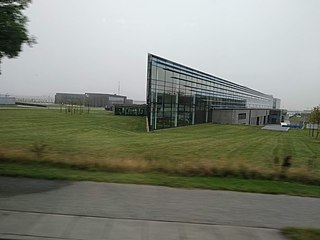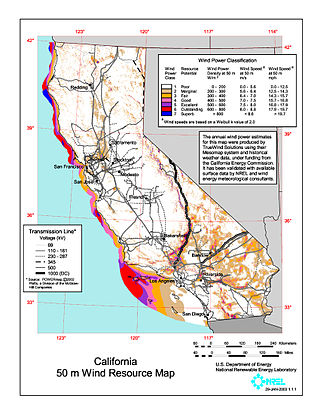
Wubbo Johannes Ockels was a Dutch physicist and astronaut with the European Space Agency who, in 1985, became the first Dutch citizen in space when he flew on STS-61-A as a payload specialist. He later became professor of aerospace engineering at Delft University of Technology.

A wind farm or wind park, also called a wind power station or wind power plant, is a group of wind turbines in the same location used to produce electricity. Wind farms vary in size from a small number of turbines to several hundred wind turbines covering an extensive area. Wind farms can be either onshore or offshore.

The Energy Research Centre of the Netherlands (ECN) is one of the largest energy research institute in Europe and holds a strong international position. With and for the market, ECN develops knowledge and technology that enable a transition to a sustainable energy system. The main office is located in Petten. ECN also has offices in Amsterdam, Eindhoven, Wieringermeer, Brussels and China. ECN has a staff of about 550 employees.


An airborne wind turbine is a design concept for a wind turbine with a rotor supported in the air without a tower, thus benefiting from the higher velocity and persistence of wind at high altitudes, while avoiding the expense of tower construction, or the need for slip rings or yaw mechanism. An electrical generator may be on the ground or airborne. Challenges include safely suspending and maintaining turbines hundreds of meters off the ground in high winds and storms, transferring the harvested and/or generated power back to earth, and interference with aviation.
Airborne wind energy (AWE) is the direct use or generation of wind energy by the use of aerodynamic or aerostatic lift devices. AWE technology is able to harvest high altitude winds, in contrast to wind turbines, which use a rotor mounted on a tower.
E.ON UK is a British energy company and the largest supplier of energy and renewable electricity in the UK, following its acquisition of Npower. It is a subsidiary of E.ON of Germany and one of the Big Six energy suppliers. It was founded in 1989 as Powergen, and was listed on the London Stock Exchange and was once a constituent of the FTSE 100 Index. It has been a subsidiary of E.ON since 1 July 2002.

Wind power has been used as long as humans have put sails into the wind. King Hammurabi's Codex already mentioned windmills for generating mechanical energy. Wind-powered machines used to grind grain and pump water — the windmill and wind pump — were developed in what is now Iran, Afghanistan, and Pakistan by the 9th century. Wind power was widely available and not confined to the banks of fast-flowing streams, or later, requiring sources of fuel. Wind-powered pumps drained the polders of the Netherlands, and in arid regions such as the American midwest or the Australian outback, wind pumps provided water for livestock and steam engines.

Wind power in California had initiative and early development during Governor Jerry Brown's first two terms in the late 1970s and early 1980s. The state's wind power capacity has grown by nearly 350% since 2001, when it was less than 1,700 MW. In 2016, wind energy supplied about 6.9% of California's total electricity needs, or enough to power more than 1.3 million households. Most of California's wind generation is found in the Tehachapi area of Kern County, California, with some large projects in Solano, Contra Costa and Riverside counties as well. California is among the states with the largest amount of installed wind power capacity. In recent years, California has lagged behind other states when it comes to the installation of wind power. It was ranked 4th overall for wind power electrical generation at the end of 2016 behind Texas, Iowa, and Oklahoma. As of 2019, California had 5,973 megawatts (MW) of wind power generating capacity installed.
A laddermill kite system is an airborne wind turbine consisting of a long string or loop of power kites. The loop or string of kites would be launched in the air by the lifting force of the kites, until it is fully unrolled, and the top reaches a height determined by designers and operators; some designers have considered heights of about 30,000 feet, but the concept is not height-dependent. The laddermill method may use one endless loop, two endless loops, or more such loops.

The European Marine Energy Centre (EMEC) Ltd is a UKAS accredited test and research center focusing on wave and tidal power development based in the Orkney Islands, UK. The centre provides developers with the opportunity to test full-scale grid-connected prototype devices in unrivalled wave and tidal conditions.

A floating wind turbine is an offshore wind turbine mounted on a floating structure that allows the turbine to generate electricity in water depths where fixed-foundation turbines are not feasible. Floating wind farms have the potential to significantly increase the sea area available for offshore wind farms, especially in countries with limited shallow waters, such as Japan, France and the United States' West Coast. Locating wind farms further offshore can also reduce visual pollution, provide better accommodation for fishing and shipping lanes, and reach stronger and more consistent winds.

Wind power in Italy, at the end of 2015, consisted of more than 1,847 wind turbines with a total installed capacity of 8,958 megawatts. Wind power contributed 5.4% of Italy electricity generation in 2015 (14,589 GWh). Italy is ranked as the world's tenth producer of wind power as of the end of 2016. Prospects for Italian wind energy beyond 2020 were positive, with several projects planned to go live before 2030.
Airborne Wind Energy Industry Association (AWEIA) was founded in 2009 to serve globally companies and institutions dedicated to converting wind energy for useful loads by use of tethered and free-flight aircraft ; the tethered and free-flight mode is in contrast to using non-tethered ground-connected wind turbines. Founders: Dave Santos, Joe Faust, John Oyebanji, and Wayne German. AWEIA is a member of Global Wind Energy Council. AWEIA is the first global-serving member of GWEC dedicated to airborne wind energy technology.
Makani Technologies LLC was an Alameda, California-based company that developed airborne wind turbines. Founded in 2006, Makani was acquired by Google in May 2013. In February 2020, Makani was shut down by Alphabet, Google's parent company.
The following outline is provided as an overview of and topical guide to wind energy:
Bas Lansdorp is a Dutch entrepreneur best known as the co-founder and CEO of the defunct Mars One.
Wind power is a form of renewable energy in South Korea with the goal of reducing greenhouse gas (GHG) and particulate matter (PM) emissions caused by coal based power. After two oil crises dating back to the 1970s, the South Korean government needed to transition to renewable energy, which encouraged their first renewable energy law in 1987.
Kitepower is a registered trademark of the Dutch company Enevate B.V. developing mobile airborne wind power systems. Kitepower was founded in 2016 by Johannes Peschel and Roland Schmehl as a university spin-off from the Delft University of Technology’s airborne wind energy research group established by the former astronaut Wubbo Ockels. The company is located in Delft, Netherlands, and currently comprises 18 employees (2018).










